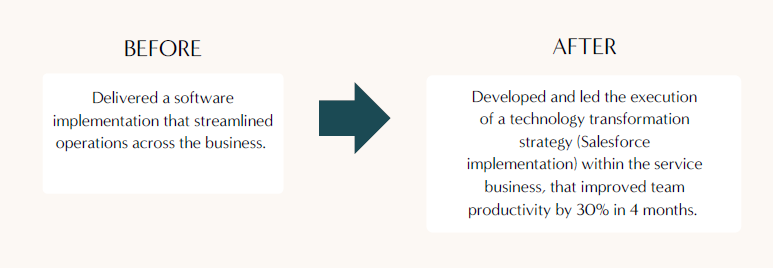Introduction
In today’s competitive job market, landing a leadership role requires more than just experience—it demands a strong leadership resume that impactfully communicates your value and/or your potential.
Employers seek candidates who truly understand how business operations align with higher-level strategic priorities and objectives. Their ideal candidate demonstrates strategic thinking, a proven track record of delivering tangible business results, as well as the all-important ability to lead people and manage teams.
A well-structured resume for managers highlights both your achievements and leadership attributes, to deliver a strong value proposition suited for senior roles. Whether you’re applying for a senior manager resume or putting together a resume for promotion, your resume should clearly showcase your ability to lead teams, implement strategies, and achieve results.
Most of us struggle to articulate our leadership attributes or experience on paper. We may have successfully managed projects, mentored teams, or delivered outstanding results, but if these achievements aren’t clearly articulated, our application will fail to catch the attention of recruiters or hiring managers. They will only know what you communicate to them!
This article will provide actionable insights on how to structure and optimise your management resume, ensuring it stands out for your ideal leadership role.
1. Understanding What Employers Look for in a Leadership Resume
1.1 What Defines a Leadership Role?
A leadership role extends beyond managing people; it involves influencing business outcomes, guiding teams, and contributing to strategy. Leadership is not just about having a managerial title—it’s about demonstrating the ability to set a vision, align teams with company objectives, and deliver measurable success. When crafting your resume, consider how your experience reflects the following leadership responsibilities:
- Strategic decision-making and long-term planning.
- Managing and optimising business operations.
- Leading teams towards organisational goals and objectives.
- Developing and implementing growth strategies.
- Engaging with stakeholders and fostering relationships that drive success.
Even if you have never held a formal managerial title, you may well have demonstrated leadership attributes in previous roles. Have you unofficially mentored junior employees? Spearheaded a cross-functional project? Suggested or led an improvement initiative?
These experiences all contribute to your leadership narrative and should be presented strongly in your resume. Think beyond traditional job titles and focus on how you have influenced and inspired others in a work setting.
1.2 The Top Skills and Qualities Employers Expect from Leaders
Employers are looking for well-rounded leaders with both technical expertise and people skills. In other words, strong leadership requires the ability to balance strategic vision with operational execution. Consider emphasising the below qualities in your leadership resume:
- Strategic Thinking: Leaders need to see the bigger picture and make data-driven decisions that align with business objectives.
- People Management & Communication: Effective leadership involves inspiring teams, managing conflicts, and fostering a culture of collaboration.
- Financial Acumen: Budget management and cost optimisation can play a critical role in leadership positions.
- Stakeholder Engagement: Whether working with internal teams or external partners, the ability to build strong relationships is key.
- Change Management: Leaders must navigate shifting priorities and help their teams adapt to new challenges.
- Crisis Management: Handling unexpected issues effectively is crucial in leadership roles.
- Decision-Making & Problem-Solving: Managers and executives must be able to make quick, informed decisions under pressure.

You can integrate these skills into your resume throughout your summary, professional experience, achievements, or skills sections.
A successful leader inspires and drives measurable impact within an organisation.
2. Structuring Your Resume for Maximum Leadership Impact
2.1 The Best Resume Format for Managers and Leaders
Choosing the right resume format for managers is crucial. A well-structured resume ensures that your leadership credentials stand out, are easy to identify, and have credibility.
- A reverse-chronological resume is the traditional format of a resume, and is generally suitable across all roles. For leadership specifically, it helps to highlight career progression and increasing responsibilities over time.
- A functional resume focuses on skills rather than experience, but is generally recommended for very specific positions, such as board or C-level positions.
- A hybrid resume (combining functional and chronological formats) works well for most circumstances, and particularly for professionals transitioning into leadership for the first time, shifting industry, or targeting a specific ideal role.
We absolutely recommend a hybrid resume for leadership and management roles!
It is a fantastic way to present the most relevant information to the hiring manager or recruiter, in a concise and easy-to-scan form.
Your senior manager resume should ideally be 2-4 pages long, in a clean and professional layout with clear headings, strategic use of white space, and ATS-friendly formatting. Avoid cluttering the resume with unnecessary information—focus on content that directly evidences your leadership capabilities.
2.2 Crafting a Powerful Resume Summary That Commands Attention

Your resume summary is the first thing recruiters see. It should quickly communicate your leadership value proposition. A compelling summary should include:
- Who you are as a professional (e.g., “Results-driven senior manager with 15+ years of experience in corporate operations”).
- Core leadership skills (e.g., “I drive operational efficiency, lead high-performing teams, and implement process improvements to deliver significant revenue growth”).
- Key attributes (e.g., “I am known for my transparent leadership style that cultivates collaboration, innovation, and productivity amongst teams.”).
This section is your elevator pitch. It sets the tone for your resume and encourages recruiters to continue reading. Write this in the first person, to add a human element to your resume, and create a connection with the reader.
3. How to Highlight Leadership Experience on Your Resume
3.1 Demonstrating Leadership Through Key Achievements
A dedicated Select Highlights section on Page 1 of your resume can also strengthen your pitch and narrative. Keep this limited to 3-5 single-line bullet points at most, for impact. Consider:
- Highlighting a particularly impressive major project you led.
- Showcasing a revenue growth or cost-reduction result you delivered.
- Include the largest team you led, or team development skills (e.g., “Mentored 5+ employees to promotion”)
- Mention an impactful strategy you developed or implemented.
Use strong action verbs such as “orchestrated,” “spearheaded,” “transformed,” and “optimised” to reinforce your leadership capabilities.
3.2 Highlighting Leadership Skills in a Dedicated Skills Section
Recruiters and hiring managers often complete a quick scan of the resumes they receive for a role, to identify key leadership and operational competencies. Including a Skills Section ensures they don’t miss crucial details and they receive the most important information within a few seconds of viewing your resume.
You can use a keyworded skills list. However, for leadership roles, a more extended skills profile is more appropriate. Include 3-5 key categories, with a 1-2 line description for each, that communicate your overall career experience in that category.
You may like to consider these categories:
- Leadership & Strategy: Business development, strategic planning.
- Operations & Financial Management: Budgeting, forecasting, cost optimisation.
- Team Development & Coaching: Employee engagement, mentorship.
- Stakeholder Relations: Cross-functional collaboration, vendor negotiations.
- Crisis & Change Management: Leading organisations through transitions and challenges.
Including a variety of leadership-related skills will ensure the reader has a quick and clear understanding of how you will fit into their role and organisation. The goal is that this profile helps to deem you as relevant as quickly as possible, and they can then proceed to explore your experience in the subsequent sections.
3.3 Showcasing Leadership in Your Professional Experience Section
Your professional experience section should provide evidence of your capabilities. Rather than listing daily responsibilities, focus on how your leadership and contributions influenced business outcomes.
Using the STAR method (Situation, Task, Action, Result) can help to drill out your highlights:
- Situation: Identify a challenge or goal you tackled.
- Task: Define your role in addressing the issue.
- Action: Describe the strategies you implemented.
- Result: Showcase the measurable impact of your contributions or leadership.
To keep things more concise, you may like to use the CAR method (Context, Action, Result):
- Context: Communicate the setting or context of the highlight.
- Action: Describe the tasks you completed or the strategies you implemented.
- Result: Showcase the measurable impact of your contributions or leadership.
If you’re feeling brave, flip the sentences around so that the result is at the beginning of the bullet point. You may even like to bold out the ‘result’ part of each highlight for greater impact.
For example: “Increased department efficiency by 30% by implementing a new workflow system, reducing processing time from 10 to 7 days.”

Conclusion & Call to Action
Crafting a strong leadership resume requires thought and a strategic approach. Clearly showcasing your leadership impact, emphasising measurable achievements, and using a compelling and simple format, will ensure you position yourself as a top candidate for your ideal leadership role.
A well-crafted resume for promotion highlights your past successes as well as your potential and readiness to take on more responsibility. Employers want to see how you have demonstrated your leadership attributes in the past, to believe that you can apply them on a greater scale.
If you need expert guidance, Elevate Career Services offers leadership resume writing services, from middle management to C-level roles. Contact us today for a free resume review, or book a discovery call with us here.






